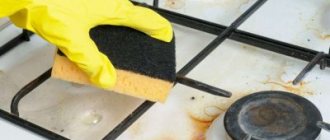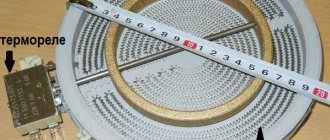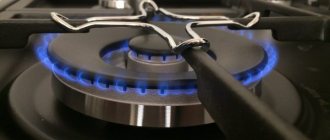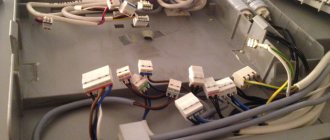Repairing a geyser with your own hands is a serious and dangerous matter. Any professional will tell you: “a geyser is a potentially dangerous piece of equipment, so you can only trust its maintenance and repair to a qualified specialist.” However, the ability to understand exactly which element has failed and what this can lead to will definitely not hurt.
DIY geyser repair
In addition, some faults that do not specifically affect gas equipment can be resolved on your own. Read the description of typical breakdowns and recommendations for action if they are detected.
Gas water heater device
Geyser refuses to ignite
Equipment may fail to light for several reasons.
Gas water heater device
Expert opinion: Masalsky A.V.
Editor of the “construction” category on the Stroyday.ru portal. Specialist in engineering systems and drainage.
First of all, you must make sure that the igniter is working properly. If it does not light, contact your gas service. A specialist will clean or replace the failed element. You cannot touch it yourself - it is dangerous.
Gas water heater diagram
In modern units with electronic ignition, if there is no ignition, the gas stops flowing - it is cut off by a valve. The user learns about this through the corresponding indicator. In some situations, this problem can be solved by simply replacing the battery. Please clarify this point in the instructions. If the manufacturer does not give such recommendations, it is better to immediately contact the gas service or a third-party repair service.
At one point the column may not light up
Battery pack for igniting the column
The column will not light up if there is no ventilation draft. To check the draft level, place a strip of paper near the ventilation grille. If the leaf does not change its position or does not change it sufficiently, there are obvious problems with traction. In apartment buildings, utility workers are responsible for cleaning ventilation shafts - contact them. You can do this yourself using a metal brush tied to a flexible wire (hose, etc.) of suitable length, but utility services usually do not approve of such unauthorized actions.
Ventilation cleaning
Often burners do not fire due to membrane wear. This structural element deforms quite quickly, the burner starting mechanism becomes less sensitive and does not work when the water is turned on. Even in expensive heaters, the membranes wear out within 5-8 years - unfortunately, nothing can be done about this.
Often burners do not fire due to membrane wear
To check, turn on the water to maximum. If the column turns on under strong pressure, the problem is definitely in the membrane. You can replace this element yourself.
To do this, do the following:
- unscrew the fastening nuts from the water unit (usually there are 2 of them);
- unscrew the fastening screws that hold the water unit in the gas unit (usually 3 screws);
- separate the halves of the assembly and you will see a rubber membrane. If it is not flat but noticeably warped, replace it. To do this, buy a similar product in a specialized store. If possible, give preference to a silicone membrane - it will last much longer than its simple rubber counterpart.
Expert opinion: Masalsky A.V.
Editor of the “construction” category on the Stroyday.ru portal. Specialist in engineering systems and drainage.
At the same stage, you can check the condition of the water intake filter. If it is clogged, clean it or replace it with a new one. To clean, simply unscrew the nut on the water supply side, remove the mesh and wash it or replace it with a new one, depending on the condition.
Find out detailed instructions on how to repair the Neva 4511 geyser yourself from our new article.
Gas water heater design and operating principle
The main components and their purposes are the same for all gas water heaters.
| Node, element | Purpose |
| Ignition unit including igniter. | Designed to ignite a gas burner. |
| Burner and fuel combustion chamber. | Provide the water heater with thermal energy. |
| Water node. | Regulates water supply. |
| Heat exchanger. | Transfers heat from the combustion chamber to the coil in which the water is heated. |
| Pipes for supplying gas and water. | For connection to gas and water supply. |
| Pipe for connection to the chimney. | Designed to remove combustion products into the ventilation shaft. |
| Control block. | Regulates the temperature of water heating. |
The geyser goes out
The geyser goes out.
If the heater turns on but goes out, the problem in most situations lies in the bimetallic temperature sensor, which is necessary to protect the equipment from overheating. Also, due to malfunctions of this element, the heater may not turn on at all.
This problem has 2 main development scenarios.
- In the first scenario, the burner lights up properly, the equipment functions for some time without any complaints, and then goes out and shows no signs of life for some time - attempts to ignite the heater lead to nothing. Usually after 20-30 minutes the equipment turns on again and history repeats itself. This occurs due to the excessive sensitivity of the sensor. As a rule, it is “congenital”, i.e. This is a factory defect. It is extremely difficult to do something on your own. It is better to immediately contact the manufacturer’s service for warranty repairs.
- In accordance with the second scenario, the column may turn off chaotically, and sometimes not turn on at all. The reason, as a rule, is the wear of the insulating material of the bimetallic sensor conductor. There is a banal short circuit to the housing, as a result of which the safety valve is activated and the column begins to behave abnormally.
Contact the service center for warranty repairs
There is no point in contacting gas workers - the defect is clearly not a “gas” defect. There is also no need to try to get rid of the breakdown yourself - you can only break the unit. Contact the service center for warranty repairs.
Water comes out with weak pressure
Water comes out with weak pressure.
Most often this happens due to the column heat exchanger being clogged with scale. Typically, the cause of clogging is prolonged “idle” firing of the igniter. The device heats the heat exchanger to a temperature sufficient to evaporate any remaining moisture.
There is no water flow, scale is not washed out of the heat exchanger, and before the next time the equipment is turned on, it sets, as a result of which the column ceases to function normally. Cleaning the heat exchanger usually helps. In advanced cases it has to be changed.
To replace it, it is better to immediately contact professionals, but you can handle the cleaning yourself. Prepare screwdrivers, rubber hose, open-end wrenches and paranitic gaskets. Buy a descaling mixture from a hardware store. This is usually called anti-scale. A more budget-friendly option is washing with vinegar essence. Work in this order.
The best all-purpose descaling products
First step. Sequentially remove the fittings and casing from the heater.
Second step. Shut off the water at the inlet and open the hot water tap, preferably as close to the water heater as possible.
Third step. Unscrew the water supply tube from the heat exchanger and then move it to the side. After unscrewing the nut, the column heat exchanger will begin to release water. In total, about 1 liter will be drained.
Fourth step. Place a hose of a suitable diameter onto the inlet of the heat exchanger and lift it slightly above the heater. Insert an ordinary funnel into the attached hose and begin to slowly pour in the prepared solution in a thin stream (preparation instructions are given on the package). There's no need to rush. If you pour too quickly, the antikipin will simply push it back out, and you are unlikely to like it.
Flushing the geyser heat exchanger
Leave the cleaning agent in the heat exchanger of the heater for 2-3 hours (usually the required time is indicated on the packaging).
Place a suitable container under the water tap and carefully resume the flow of liquid to the heater. Observe what comes out of the hose. Did a lot of sludge come out, and then the pressure returned to normal? Everything is fine. Otherwise, the washing will have to be done again. Typically, the need to re-rinse occurs only when using vinegar essence. Antiscale can cope with most situations the first time.
What components can you repair yourself?
Sometimes disassembly of a gas water heater is required to repair a specific part. In this case, you need to know how to properly disassemble the column assembly. The following problems indicate the presence of a breakdown in a particular element:
- the burner does not light;
- the flame is yellow;
- After some time after operation, the burner goes out.
How to disassemble the water block of a water heater
The reason for the lack of ignition is often a stretched or deformed membrane of the water unit. Regardless of the quality of the water heater, any water block gradually becomes unusable. Its maximum service life is 8 years. The elastic membrane located in the water unit, under the influence of hard water and a moving rod, gradually stretches, deforms or even breaks. As a result, the once elastic element loses sensitivity and does not respond to increased water flow - this leads to the fact that the ignition signal is not given.
…
You can check the involvement of the water heater water block in the absence of ignition if you open the tap so that the water flow is maximum. If after this the gas water heater lights up, but this does not happen at lower pressure, then the reason is in the membrane of the water block.
To get to the membrane and replace it with a new one, you need to unscrew the two nuts of the water unit and the three bolts that secure it.
After this, the part is separated into two parts. The damaged membrane is removed from the block and a new one is installed in its place. Note! When purchasing a new membrane for a water unit, it is better to choose a silicone part.
It has a longer service life than rubber. When disassembling the water unit, you should immediately check the filter. If the mesh is clogged with dirt and scale, it should be cleaned or replaced with a new one. Now the water unit is assembled in the reverse order - install all the parts and tighten the housing with bolts.
How to remove the thermal fuse
The thermal fuse is a bimetallic plate, which, when the temperature reaches 90°C, bends so that the rod breaks the power supply circuit of the solenoid. The temperature sensor is connected to the circuit using terminals. But it happens that this element is triggered at low temperatures and then the column goes out uncontrollably.
You can check whether the thermal fuse is involved in the burner going out in the following way: remove the terminals from the part and short-circuit them between an object made of metal, for example, a paper clip. If after this the burner shutdowns stop, the problem is with the temperature sensor. It is replaced with a new one. As a temporary measure, you can leave a paperclip between the terminals, but it should not touch any metal parts.
The thermal fuse is attached to the heat-resistant plastic adapter with two bolts. The element is removed by unwinding them.
How to disassemble the igniter
If the flame is yellow or the gas heater turns on accompanied by a popping noise, it means the igniter needs to be cleaned. Over time, the element becomes clogged with soot and then the flame of the wick becomes insufficient for quick ignition. The gas accumulates and when large volumes of it ignite, a bang occurs. In another case, the fuel does not burn completely due to lack of oxygen, so the flame is not blue, but yellow.
To remove the igniter for cleaning, unscrew the nut that secures the fuel supply tube, then unscrew the two outer screws. Now you should pull the bar towards you and lift it up. The nozzle is clamped by the gas pipeline and falls out when it is loosened. After this, the part is removed to the side and the igniter channel is cleaned with a thin wire.
Column "claps"
The column “pops”
In such a situation, it is better to immediately contact a professional. He will make adjustments, which are extremely difficult to make without knowledge of the matter, and the column will begin to work normally.
You can find out the reasons for the appearance of such a malfunction for general development. There are two main reasons:
- gas flows under too much pressure. The heater lights up too actively, which leads to a fire failure;
- gas flows at too low a pressure. Air penetrates into the heater burner, which leads to a micro-explosion, which is interpreted by human hearing as a bang.
How to check draft in a gas water heater
First of all, if problems arise with the water heater, check the draft. To do this, bring a lit match or a piece of paper to the exhaust hole:
- if the flame does not move, then there is a problem in the chimney or exhaust system. To do this, you can simply remove the accumulated dirt;
- if the flame draws inward, it means the system is working perfectly;
- if the flame deviates in the opposite direction, this means the appearance of reverse draft, which is extremely dangerous. To do this, you should check it in the ventilation shaft, having first disconnected the chimney from it. If the ventilation duct is working normally, the flame on the match deviates inward, which means there are problems in the heat exchanger.
It is important! Checking traction with a match should be abandoned if there is a risk of gas leakage.
The water heater does not heat the water enough
The water heater does not heat the water enough.
This usually happens due to the insufficient power of the gas water heater. The user begins to demand more from the equipment than it can do.
There are two options to solve the problem:
- we stop abusing and do not open hot taps at all water intake points at the same time;
- We buy a more powerful speaker.
Expert opinion: Masalsky A.V.
Editor of the “construction” category on the Stroyday.ru portal. Specialist in engineering systems and drainage.
Also, inadequate heating of the liquid may occur due to a clogged burner. Look at the color of the fire. Under normal conditions it is bluish. If the flame turns yellow, contact a gas specialist. You can only trust such repairs to a professional, because... This is already a “gas” breakdown.










